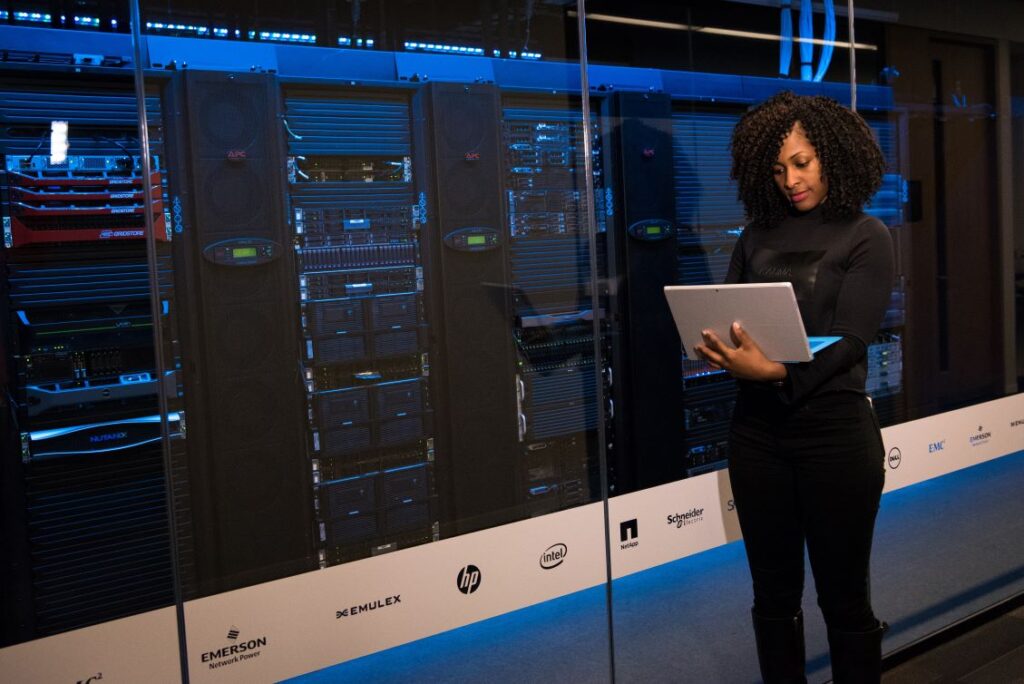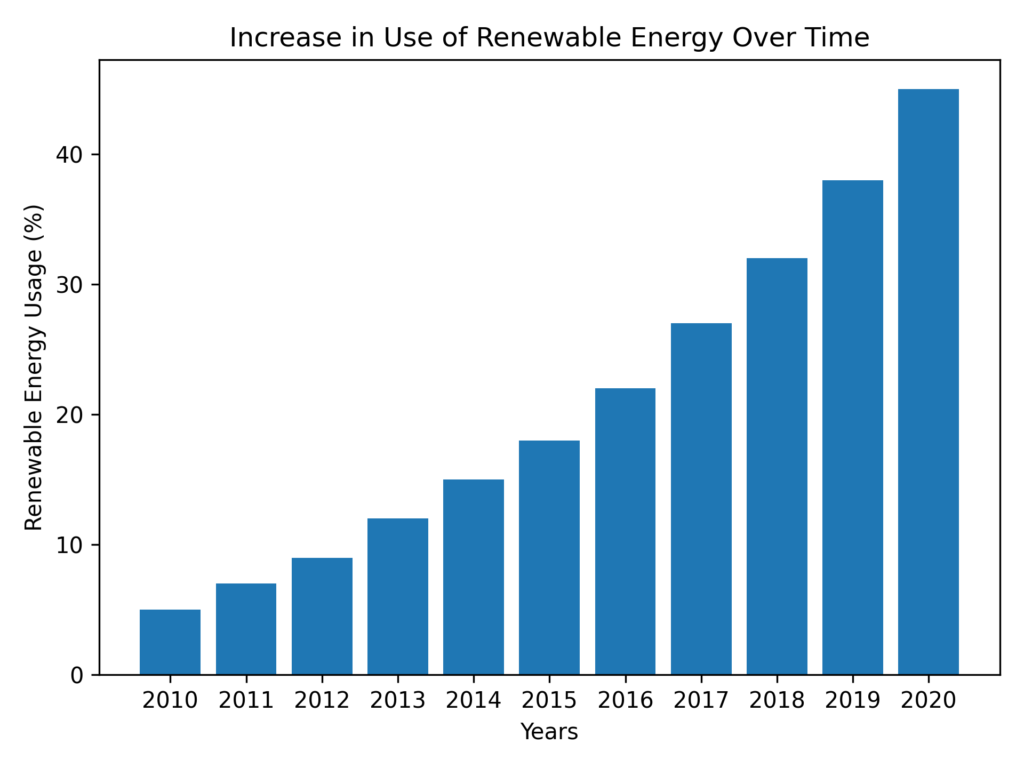Introduction: Navigating the Double-Edged Sword of Our Digital Lives

Ah, the digital age, a time when we’re more connected than ever, but at what cost? Ever catch yourself marveling at your new smartphone and then suddenly think, “Wait a minute, what’s the eco-footprint of this bad boy?” Or how about those data centers humming away in the background, powering your binge-watching sessions? Yep, it’s a hard pill to swallow, but our love affair with tech is leaving Mother Earth feeling more than a little unloved.
But hold the phone there’s a sea change afoot. As the grim reality of climate change becomes too loud to ignore, companies and everyday folks like you and me are waking up and smelling the (sustainably sourced) coffee. This isn’t just about saving the whales anymore; it’s about saving ourselves. And guess where this change is most palpable? You got it in the world of hardware, where “sustainable” is fast becoming the new “new.”
Why Tech Sustainability is More Than Just a Buzzword
Let’s get one thing straight, going green in tech isn’t just a fad; it’s a do-or-die situation. With more consumers demanding eco-friendly options and governments cracking down with tougher regulations, companies that don’t get with the program could find themselves left in the dust. And here’s the kicker: going green can save you some green in the long run, especially as renewable energy tech gets cheaper and more efficient.
What You’ll Get from This Read
So, what’s in store for you in this article? Think of it as your go-to guide for all things sustainable tech, with a spotlight on hardware that’s doing its part to keep our planet cool. We’ll dive into why making the switch to eco-friendly tech is not just smart but essential, and what that switch looks like in practice. You’ll get the lowdown on some of the most innovative green gadgets out there and how they’re making a real difference.
Here’s a sneak peek of the hot topics we’ll cover:
- The dirty little secrets of traditional tech’s environmental impact
- The ABCs of sustainable technology what it is and why it matters
- A roundup of game-changing, eco-friendly hardware that’s turning heads
- The nitty-gritty numbers that prove why going green is a win-win
By the time you reach the end of this article, you’ll be armed with a wealth of knowledge about the current state of sustainable tech, especially in the hardware game, and why it should matter to all of us.
The Pressing Need for Green Tech: It’s Now or Never
The Environmental Toll of Old-School Tech
Let’s face it, our tech obsession comes with some serious environmental baggage. Ever wonder what’s behind that shiny new gadget you can’t live without? Spoiler alert: it’s not pretty. Traditional tech is a resource hog, guzzling energy and spitting out waste like there’s no tomorrow. Take rare earth metals, for example. Mining these babies wreaks havoc on our planet, from destroying habitats to contaminating our soil and water. And let’s not even get started on the carbon emissions.

But wait, there’s more. Data centers, the unsung heroes powering your endless scrolling, are energy vampires. These behemoths suck up electricity like it’s going out of style, and guess where most of that energy comes from? Yep, good old fossil fuels. To add insult to injury, these centers get so hot they need even more energy for cooling. Talk about a vicious cycle, huh?
And let’s not forget the elephant in the room: e-waste. We’re tossing out old gadgets at an alarming rate, and where do they end up? Landfills, mostly, leach all sorts of nasties into the ground and air. Or they get burned, sending toxic fumes into the atmosphere. Either way, it’s a lose-lose.
Why We Can’t Afford to Drag Our Feet on Eco-Friendly Tech
So, where does that leave us? At a crossroads, my friend. With climate change breathing down our necks and a growing global population that’s more tech-reliant than ever, we’re running out of time to turn this ship around. And let’s be clear: half-measures won’t cut it anymore.
But it’s not just about saving the planet; it’s about saving ourselves. The ripple effects of tech’s environmental impact are global, messing with everything from weather patterns to public health. Ever think about how the loss of biodiversity could affect your dinner plate or even your medicine cabinet? Yeah, it’s that serious.
And let’s talk social justice. The environmental fallout from tech hits marginalized communities the hardest. They’re the ones dealing with polluted air and water, and they’re the ones who’ll pay the price if we don’t act now. On the economic front, the costs of doing nothing cleaning up environmental messes, healthcare, lost productivity are sky-high and climbing.
Wrapping It Up: The Multi-Faceted Case for Sustainable Tech
In a nutshell, the push for sustainable tech isn’t just an “environmental thing.” It’s a tangled web of social, economic, and yes, environmental challenges that we can’t afford to ignore. Switching to eco-friendly hardware isn’t just a step in the right direction; it’s a leap toward a more sustainable future for all of us.
Unpacking the Intricacies of Sustainable Tech: It’s Not Just a Buzzword
The Nitty-Gritty: What Sets Sustainable Tech Apart?
When we delve into the realm of sustainable technology, it’s crucial to grasp that we’re talking about a game-changing philosophy. This isn’t just a subgenre of the tech world; it’s a full-blown revolution that places environmental responsibility at its core. So, what’s the secret sauce that differentiates sustainable tech from its conventional counterparts?
Mastering the Art of Resourcefulness: First and foremost, sustainable tech is all about making every resource count. This ethos is woven into the fabric of the entire product lifecycle, from the drawing board to the recycling bin.
Minimizing Mother Nature’s Woes: The goal here is straightforward but monumental: do less harm. That means cutting down on greenhouse gas emissions, keeping our waters clean, and reducing waste like there’s no tomorrow.
Built to Last: Ever heard the saying, “They don’t make ’em like they used to”? Well, in the world of sustainable tech, they do. Durability isn’t just a feature; it’s a mandate, reducing the need for frequent upgrades and, by extension, waste.
The Mod Squad: Modular designs aren’t just trendy but smart. They make repairs and upgrades a breeze, extending the life of products and keeping them out of landfills.
Ethics in Action: Companies in this space aren’t just talking the talk; they’re walking the walk with ethical sourcing and transparent supply chains.
Penny Wise, Planet Wise: Sure, the initial costs might make you wince, but the long-term savings both for your wallet and the planet are undeniable.
The Full Spectrum: Hardware and Software in the Green Tech Ecosystem

Sustainable tech isn’t a one-size-fits-all solution; it’s a multifaceted universe brimming with both hardware and software innovations, each playing a unique role in the grand scheme of environmental sustainability.
Sustainable Hardware:
- Harnessing Nature’s Power: We’re talking solar panels, wind turbines, and other gadgets that turn renewable energy into usable power.
- Smart Consumption: Think energy-efficient lighting and HVAC systems that redefine how we use electricity.
- Green Materials: Biodegradable and recycled materials are the building blocks of the future.
- Waste Not, Want Not: Devices like smart thermostats and precision irrigation systems are making waste a thing of the past.
Sustainable Software:
- Lean and Mean Algorithms: Software is getting smarter, doing more with less energy.
- Virtual Efficiency: Virtualization and resource pooling mean we need fewer physical servers, reducing our carbon footprint.
- Data-Driven Decisions: Analytics tools are helping companies measure and reduce their environmental impact.
- Transparent by Design: Thanks to blockchain, supply chain practices are more transparent than ever.
In a nutshell, sustainable technology is a complex, cross-disciplinary field that’s all about balancing tech innovation with environmental responsibility. Whether it’s hardware that conserves resources or software that maximizes efficiency, the end goal is the same: a greener, more sustainable future for us all.
Eco-friendly Hardware Innovations: The Future is Now, Folks!
Renewable Energy-Powered Gizmos
So, you’re tired of your gadgets guzzling fossil fuels like there’s no tomorrow? Enter renewable energy-powered devices. We’re talking solar-powered chargers that juice up your phone and wind turbines that could power your entire home. Cool, right? It’s like having your cake and eating it too, but in a way that Mother Earth would give a thumbs up!
Stuff That Won’t Stick Around Forever (In Landfills)
Ever thought about where your old phone or laptop ends up? Spoiler alert: it’s not a happy place. That’s why biodegradable materials are the talk of the town. Imagine a phone case that just decomposes naturally over time. No more tech graveyards, and less guilt the next time you decide to upgrade.
Components That Won’t Break the (Energy) Bank
Energy-efficient components are where it’s at. Think processors that do more with less juice or LED lights that are as bright as your future. It’s not just about saving on your electricity bill (although who doesn’t love that?), it’s about cutting down those nasty carbon emissions. Win-win, anyone?
Lego for Grown-Ups: Modular Designs
Remember the joy of playing with Lego blocks? Modular designs bring that same “snap-and-play” fun to your gadgets. Broken screen? Just swap it out. Need more storage? Plug it in. It’s the kind of tech that grows with you, making both your wallet and the planet a whole lot happier.
The Cool Kids on the Block

- Tesla: These guys are the rockstars of the renewable energy world. Solar roof tiles, electric cars, you name it. Tesla is making green look good.
- Fairphone: Ever heard of a phone you can fix with a single screwdriver? Fairphone’s doing it, and they’re sourcing materials responsibly to boot.
- Echogen Power Systems: These folks are turning waste heat into electricity. Talk about making the best of a bad situation!
- Ecovative Design: Imagine replacing plastic with mushroom-based materials. Sounds like science fiction, but Ecovative is making it happen.
So, what’s the takeaway here? Eco-friendly hardware innovations are more than just buzzwords; they’re game-changers that are setting us on a path to a more sustainable future. And the best part? This is just the tip of the iceberg.
The Profound Ripple Effects of Eco-friendly Hardware: It’s More Than Just a Green Sticker
The Environmental Boon: A Breath of Fresh Air
Let’s cut to the chase: the environmental benefits of eco-friendly hardware are nothing short of revolutionary. By leveraging renewable energy sources, these devices dramatically slash greenhouse gas emissions. Imagine a world where your smartphone is powered by the sun or the wind; we’re talking about a seismic shift in how we interact with our planet. Moreover, the use of biodegradable materials and energy-efficient components not only minimizes waste but also reduces the extraction of virgin materials. This is a win-win for Mother Earth, as it alleviates the strain on natural ecosystems and curtails the pollution often associated with material extraction and processing.
The Dollars and Cents: Economic Upsides You Can’t Ignore
Now, you might be thinking, “All this green tech sounds great, but what’s it going to cost me?” Here’s the kicker: in the long run, it could save you money. Energy-efficient appliances and devices often have lower operating costs, translating to smaller utility bills. And let’s not forget the potential for job creation. As demand for sustainable products grows, so does the need for skilled workers in green tech sectors. It’s a burgeoning field with economic ripples that extend far beyond individual consumers.
The Social Fabric: More Than Just a Feel-Good Factor
But what does this mean for society at large? Well, the social implications are profound. Eco-friendly hardware can play a pivotal role in reducing the environmental injustices that disproportionately affect marginalized communities. Cleaner technologies mean cleaner air and water for everyone, leveling the playing field in a very tangible way. Additionally, the ethical sourcing practices associated with sustainable tech can have a positive impact on labor conditions globally, contributing to a more equitable world.
Quantitative Analysis—The Numbers Don’t Lie
If you’re a data junkie, this is where your ears perk up. Numerous studies have quantified the impact of eco-friendly hardware:
- A report by the International Renewable Energy Agency (IRENA) suggests that increasing the share of renewable energy could result in global GDP gains of up to £1 trillion.
- According to the Environmental Protection Agency (EPA), Energy Star-certified products saved consumers over £25 billion in energy costs in a single year.
- A study published in the Journal of Cleaner Production found that the use of biodegradable materials could reduce industrial waste by up to 40%.
- The World Health Organization (WHO) estimates that around 7 million premature deaths annually are linked to air pollution, a number that could be significantly reduced with cleaner energy solutions.
In summary, the adoption of eco-friendly hardware isn’t just a moral imperative; it’s an environmental, economic, and social game-changer. The data backs it up, the planet desperately needs it, and future generations will thank us for it. So, the question isn’t whether we can afford to make the switch to sustainable tech, but rather, can we afford not to?
Navigating the Minefield: Challenges and Limitations of Eco-friendly Hardware

Technical Quandaries: No Walk in the Park
Let’s not sugarcoat it: the road to sustainable tech is fraught with technical challenges. For starters, renewable energy sources like solar and wind are intermittent by nature. How do we store excess energy for those cloudy or windless days? Battery technology has come a long way, but it’s not quite there yet. And speaking of batteries, the hunt for eco-friendly, high-performance alternatives to lithium-ion is still very much a work in progress.
Moreover, the development of biodegradable materials that can match the performance and durability of their non-biodegradable counterparts is no small feat. We’re pushing the boundaries of material science, but it’s a complex dance between sustainability, functionality, and longevity.
Economic Barriers: The Elephant in the Room
Ah, the almighty dollar. It’s a stumbling block that can’t be ignored. While the long-term benefits of eco-friendly hardware are compelling, the initial investment can be a hard pill to swallow. Whether it’s the cost of R&D for companies or the retail price for consumers, financial constraints are a significant hurdle. And let’s not forget the economic inertia tied to traditional tech; entire industries are built around it, and they won’t pivot overnight without a fight.
Regulatory Hurdles: Navigating the Red Tape
You’d think that governments would be all over this like white on rice, but alas, the regulatory landscape is a mixed bag. On one hand, we have progressive policies that incentivize sustainable practices through tax breaks and grants. On the other, we’re still grappling with outdated regulations that were designed for a less enlightened era. For instance, some zoning laws make it challenging to install wind turbines or solar panels in residential areas. And don’t even get me started on the international trade laws that can stymie the ethical sourcing of materials.
So, where does this leave us? Well, it’s clear that while the promise of eco-friendly hardware is tantalizing, the path is laden with obstacles. But here’s the silver lining: challenges are just opportunities in disguise. They force us to innovate, to think outside the box, and to come together as a global community to solve some of the most pressing issues of our time.
The Horizon Ahead: Future Outlook on Eco-friendly Hardware
Upcoming Innovations: The Dawn of a New Era
So, what’s cooking in the innovation kitchen? Well, let me tell you, the future is looking brighter than a solar farm at high noon. We’re talking about quantum leaps in renewable energy storage, with next-gen batteries that are not only more efficient but also far less reliant on rare earth metals. Imagine a world where your smartphone charges in seconds and lasts for days. Sounds like science fiction, but it’s closer to reality than you might think.
And let’s not overlook the burgeoning field of biomimicry, where engineers are drawing inspiration from nature to develop more efficient and sustainable tech solutions. Picture wind turbines designed to mimic the aerodynamics of humpback whale fins, optimizing energy capture. It’s not just groundbreaking; it’s revolutionary.
Policy Changes: The Winds of Change
Policy-wise, the tides are turning, albeit slowly. Governments are beginning to wake up to the urgency of the situation. We’re seeing more aggressive carbon reduction targets, stricter regulations on e-waste, and even some preliminary discussions around a global ‘tech tax’ on companies that don’t meet sustainability benchmarks. These policy shifts are the building blocks of a more sustainable future, and while there’s still a mountain to climb, at least we’re making our way up the slope.

Public Awareness and Education: Knowledge is Power
But what about you, the consumer? How do you fit into this jigsaw puzzle? Public awareness and education are the secret sauces that could accelerate the adoption of eco-friendly hardware. The more you know, the better choices you’ll make, right? Schools are starting to integrate sustainability into their curricula, and social media campaigns are doing a bang-up job of raising awareness about the environmental impact of our tech choices.
Moreover, companies are jumping on the bandwagon with transparent marketing strategies that highlight their sustainability efforts. Ever seen those eco-labels on products? They’re not just for show; they’re a step towards educating the consumer on what they’re actually buying.
In a nutshell, the future of eco-friendly hardware is a tapestry woven from the threads of innovation, policy reform, and public awareness. It’s a complex and challenging journey, but one that holds the promise of a more sustainable world for us and the generations to come. So, are you excited about what the future holds? Because you should be. The best is yet to come.
Conclusion: The Roadmap to a Sustainable Technological Future
Summary of Key Points: The Crux of the Matter
In this comprehensive exploration, we’ve delved into the multifaceted landscape of sustainable technology, dissecting its key characteristics, its diverse applications in both hardware and software, and its far-reaching impact on environmental, economic, and social spheres. We’ve also navigated through the challenges and limitations that stand as roadblocks on the path to a more sustainable future. But remember, these challenges are not insurmountable; they are but stepping stones on the road to innovation and progress.
Call to Action: Your Role in the Grand Scheme
So, where do you fit into this intricate tapestry? The answer is simple yet profound: You are the catalyst for change. Your choices, as a consumer and as a citizen, have the power to drive this transformation. So, the next time you’re eyeing that shiny new gadget, take a moment to consider its environmental footprint. Advocate for sustainable practices in your community and workplace. After all, if not you, then who? If not now, then when?
Additional Resources: Further Your Understanding
Books:
- “Cradle to Cradle: Remaking the Way We Make Things” by William McDonough & Michael Braungart
- “The Upcycle: Beyond Sustainability—Designing for Abundance” by William McDonough & Michael Braungart
- “Sustainable Energy – Without the Hot Air” by David J.C. MacKay
Websites:
Other Resources:
- TED Talks on Sustainable Technology
- Online courses on sustainability and tech
In closing, the journey toward a sustainable technological future is a collective endeavor, one that requires the concerted efforts of individuals, corporations, and governments alike. The road ahead is fraught with challenges, but it’s also brimming with opportunities. So, are you ready to be part of the solution? Because the time for action is now.




